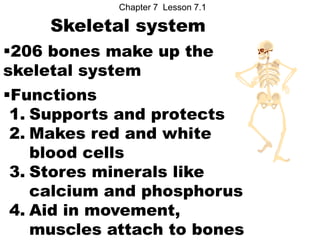
Biology Lesson7.1
- 1. Chapter 7 Lesson 7.1 Skeletal system 206 bones make up the skeletal system Functions 1. Supports and protects 2. Makes red and white blood cells 3. Stores minerals like calcium and phosphorus 4. Aid in movement, muscles attach to bones
- 2. MUSCULAR SYSTEM FUNCTION - MOVEMENT MORE THAN 650 MUSCLES IN THE BODY Two categories: VOLUNTARY AND INVOLUNTARY MUSCLES ALSO RESPONSIBLE FOR THE HEART BEATING AND YOU BREATHING
- 3. SKELETAL SYSTEM Two broad divisions: 1. Axial skeleton •trunk of the body •Includes a. vertebral column b. skull c. thoracic cage (ribs, sternum, and vertebrae), d. hyoid bone (in the neck)
- 4. SKELETAL SYSTEM Two broad divisions: 1. Axial skeleton Appendicular skeleton – 2. the appendages and their girdles (where they attach to the axial skeleton).
- 5. Axial skeleton Skull – Cranial bones divided into two main parts: 1. CRANIUM LARGEST PART OF THE SKULL IS MADE OF THE CRANIAL BONES HAS 8 BONES THAT ARE JOINED INCLUDES BONES OF THE BACK OF HEAD, SIDE, AND TOP
- 6. Axial skeleton Skull – Cranial bones divided into two main parts: 1. CRANIUM 2. FACIAL 14 BONES FACE AND JAW
- 7. Bones of the Cranium
- 8. Parietal
- 9. Occipital
- 10. Temporal
- 11. Sutures - in adults where the bones of cranium are joined tightly together which will absorb shock. Frontanels – tough membrane in babies/children where the bones of cranium are connected which allows a baby’s brain to grow.
- 13. Facial Bones
- 14. Frontal
- 15. Maxilla Makes up central portion of face Where upper teeth are attached Maxilla
- 16. Mandible •Lower jaw •Lower teeth attach •Moves •Held to skull by ligaments •Ligaments are Mandible connective tissue that hold bones to bones
- 17. Palate – roof of mouth formed by palatine bones and maxillary bones Palatine bone Maxilla
- 18. Sinuses – air-filled pockets (hollow spaces in the bone) located within the bones of the face and around the nasal cavity. Function: Sound resonation Makes skull
- 19. Hyoid bone – in the upper neck and where muscles like tongue attach.
- 20. Smallest bones of body in the ear and include: Malleus (hammer) Incus (anvil) Stapes(stirrup) Function: to amplify the sound
- 21. Vertebral Column Function: to protect the spinal cord and support the body. Composed of 26 vertebrae or individual bones.
- 22. Types of Vertebrae: •7 cervical (head attaches) •12 thoracic (ribs attach) •5 lumbar (support weight) •5 fused sacral – five fused vertebrae • 4 fused coccyx also called the tailbone
- 24. C1: To blood supply to the head, pituitary gland, scalp, bones of the face, brain inner and middle ear, sympathetic nervous system, eyes, ears C2: To eyes, optic nerves, auditory nerves, sinuses, mastoid bones, tongue, forehead, heart C3: To cheeks, outer ear, face, bones, teeth, trifacial nerve, lungs C4: To nose, lips, mouth, Eustachian tube, mucus membranes, lungs C5: To vocal cords, neck glands, pharynx C6: To neck muscles, shoulders, tonsils C7: Tothyroid gland, bursa in the shoulders, elbows T1: To arms from the elbows down, including hands, arms, wrists and fingers; esophagus and trachea, heart T2: To heart, including its valves and covering coronary arteries; lungs bronchial tubes T3: To lungs, bronchial tubes, pleura, chest, breast, heart T4: To gallbladder, common duct, heart, lungs, bronchial tubes T5: To liver, solar plexus, circulation (general), heart, esophagus, stomach T6: To stomach, esophagus, peritoneum, liver, duodenum T7: To kidneys, appendix, testes, ovaries, uterus, adrenal cortex, spleen, pancreas, large intestine T8: To spleen, stomach, liver, pancreas, gallbladder, adrenal cortex, small intestine, pyloric valve T9: To adrenal cortex, pancreas, spleen, gallbladder, ovaries, uterus, small intestine T10: To kidneys, appendix, testes, ovaries, uterus, adrenal cortex, spleen, pancreas, large intestine T11: To kidneys, ureters, large intestine, urinary bladder, adrenal medulla, adrenal cortex, uterus, ovaries, ileocecal valve T12: To small intestine, lymph circulation, large intestine, urinary bladder, uterus, kdneys, ileocecal valve L1: To large intesine, inguinal rings, uterus L2: To appendix, abdomen, upper leg, urinary bladder L3: To sex organs, uterus, bladder, knee, prostate, large intestine L4: To prostate gland, muscles of the lower back, sciatic nerve L5: To lower legs, ankles, feet, prostate Sacrum: To hip bones, buttocks, rectum, sex organs, genitalia, urinary bladder, ureter, prostate Sacral Plexus: Forms the sciatic as well as other nerves that go to muscles, joints and other structures of the legs, knees, ankles, feet and toes Coccyx: To rectum, anus
- 25. Spinal curvature: Spine is “S” shaped with 4 curvatures: cervical – convex (forward) thoracic – concave (back) lumbar – convex (forward) sacral – concave (back) Curved spine acts as a shock absorber, and for strength and
- 27. Vertebral column is made up of vertebrae stacked upon each other.
- 28. •Between the vertebrae are the intervertebral disc made up of cartilage. •Cartilage – tough, rubbery connective tissue. •Disk act as shock absorbers.
- 29. Atlas and axis – first two cervical vertebrae that support head and allow for sideways movement.
- 30. Abnormalities of the curvature of the spine: Scoliosis – abnormal sideways curve of the spine. Kyphosis – (hunchback) abnormal curve of the thoracic vertebrae Lordosis – (swayback) abnormal curve of the lumbar vertebrae
- 32. Thoracic cage: Function: protects organs such as the heart and lungs Includes: ribs and sternum
- 33. Ribs Attach to the thoracic vertebrae in back and most attach to the sternum in the front by costal cartilage There are 12 pairs for both male and female, but one of best areas for regenerating
- 34. Types of Ribs: •True ribs – first seven pairs that connect to sternum directly by costal cartilage. •False ribs – last five pair that indirectly attach by joining the cartilage of the 7th rib or don’t attach to the sternum at all.
- 35. Types of Ribs: •True ribs •False ribe •Floating ribs – last two pairs of false ribs that do not attach to sternum directly or indirectly.
